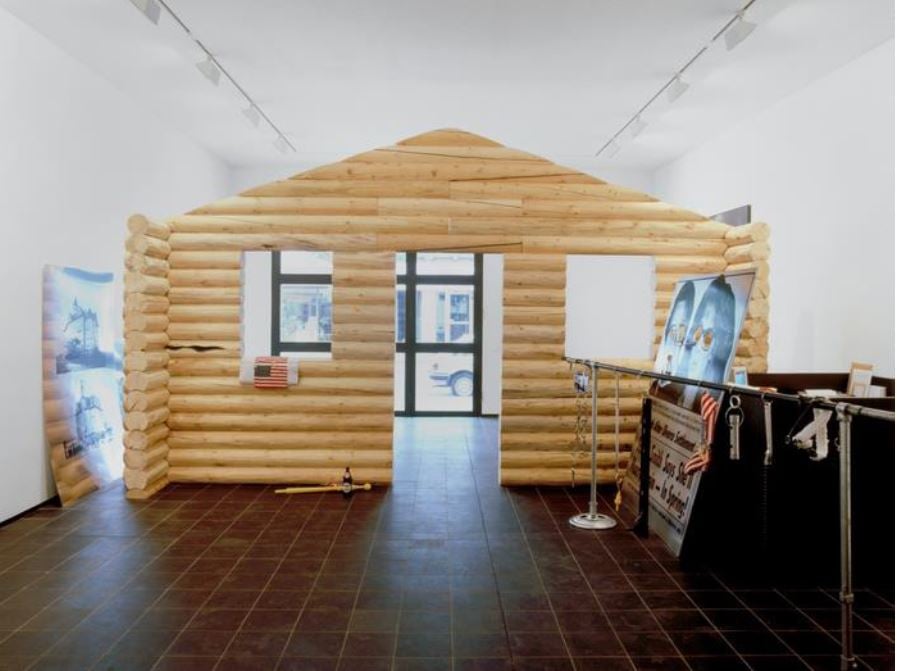
Is it possible to conserve an artwork so much that it becomes something entirely different? And can you sue someone for such an act?
These questions have been put before a federal judge for the third time by the artist Cady Noland, who has filed an appeal in an ongoing dispute over her sculpture Log Cabin (1990). Noland argues that the restoration of the work was so extreme that it amounted to the creation of an unauthorized copy of the original. A judge dismissed her lawsuit on March 8, but gave the artist the chance to replead her case one final time.
The recent ruling found that Noland—one of the most elusive and sought-after American artists working today—could not sue under the US Copyright Act because the restoration of the altered work took place in Germany. “Noland does not allege any domestic act of infringement,” wrote Judge J. Paul Oetken.
News of the lawsuit’s dismissal was reported earlier this month by the Art Law Blog, but there have been multiple filings in recent months, including the third version of Noland’s complaint and a new motion to dismiss from the case’s three defendants: Berlin’s Galerie Michael Janssen, collector Wilhelm Schürmann, and KOW Gallery, also in Berlin.
The case raises questions about what makes a work of art unique, what a collector is or isn’t allowed to do with art he owns, and at what point conservation becomes tantamount to creating an entirely new object. But at this stage, it has devolved largely into procedural questions of who has the right to sue where.
If Noland hopes to prevail this time around, she needs to prove that the first act of infringement on her Log Cabin copyright took place in the US. That would mean the law would apply to subsequent acts of infringement that took place in Germany.
Log Cabin’s Origins
The trouble began when Log Cabin‘s owner, collector Wilhelm Schürmann, loaned the work to a museum in Aachen, Germany, in 1995. After several years on display outdoors, the wood began to rot. Conservators replaced the original components were replaced with new logs sourced from the same Montana manufacturer that Noland used for the original.
Schürmann later worked with several galleries and private dealers to sell the work to Ohio art collector Scott Mueller for $1.4 million. The sales contract, however, included 12-month buy-back option should Noland, known for her controlling nature, disavow the work—which was exactly what happened after she learned of the work’s conservation.
A lawsuit brought by Mueller over the refund was dismissed by a judge in December 2016. But Noland filed her own suit in July 2017, arguing that Schürmann was reckless to install it outside and could have taken less drastic measures to fix the damage. The defendants soon fought back, looking to have the case dismissed.
Where Can She Sue?
In her new complaint, Noland argues that she has standing to sue in the United States because the sculpture was marketed in the country. Andrew Epstein, Noland’s lawyer, has focused on the fact that photographs of the refurbished sculpture were distributed in the US to market the work to potential buyers, though he also cites a German attorney who claims that German law recognizes her authorship of the work and her exclusive right to reproduce it.
(In their own motion, the defendants note that it is considered fair use to provide photographs of a copyrighted work to a potential purchaser. They also note that the photographs in question were taken after the work was altered in Germany, which would mean the inciting act still took place overseas.)
The defendants’ lawyers also claim that because the artwork was rebuilt to the specifications of the original blueprints, using logs sourced from the same source, the restoration falls within an owner’s established legal rights to repair or improve copyrighted property.
“Plaintiff’s stretched reading of ‘copying,’ taken to its logical conclusion, would mean that a reproduction has occurred when the owner of a home embodying a copyrighted design replaces its damaged siding or its leaking roof,” argues the new motion to dismiss.
“Plaintiff has been given four opportunities to plead a legally viable theory of copyright infringement; she has failed to do so,” the galleries and collector’s lawyer states in her filing.
She points out that Noland was only allowed to resubmit her complaint in order to show that her rights were first infringed upon in the US, not Germany, but that “plaintiff pleads the exact opposite: she specifically alleges acts of infringement in Germany, allegedly followed by acts of domestic distribution.”
The defendants have asked the court to dismiss the case.